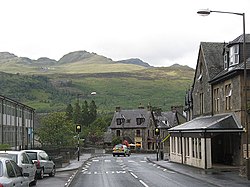Killin
| Killin Gaelic: Cill Fhinn | |
| Perthshire | |
|---|---|
 Main Street, Killin with Meall nan Tarmachan beyond | |
| Location | |
| Grid reference: | NN572328 |
| Location: | 56°27’58"N, 4°19’5"W |
| Data | |
| Population: | 666 (2001) |
| Post town: | Killin |
| Postcode: | FK21 |
| Dialling code: | 01567 |
| Local Government | |
| Council: | Stirling |
| Parliamentary constituency: |
Stirling |
Killin is a village standing at the western head of Loch Tay in Perthshire. Its name is Gaelic: Cill Fhinn means 'the White [or Fair] Church'.
The west end of the village is magnificently sited around the scenic Falls of Dochart, the main street leading down towards the Loch at the confluence of the rivers Dochart and Lochay. The falls are crossed by a narrow, multi-arched stone bridge carrying the main A827 road into Killin.
Killin railway station was on the Killin Railway. The railway station was officially closed on 1 November 1965.
Killin has a small primary school with 56 pupils. Teaching staff are shared with Strathyre. For secondary education the children have to travel to Callander, 21 miles to the south.
History
The Clan MacNab were once dominant here, and have long been associated with Killin. Their ancient burial ground is on Inchbuie in the River Dochart, just below the falls, and is visible from the bridge.
Kinnell House was the seat of the MacNabs. A well preserved prehistoric standing stone circle (possibly 'restored' to improve its appearance) can be seen in the grounds of the house. To the north of the village lie the ruins of the stronghold of the Campbells of Breadalbane, Finlarig Castle, with its associated chapel. The growing power of the Campbells eventually ousted the MacNabs, who lost Kinnell House to their rivals. In 1694 Sir John Campbell of Glenorchy, 1st Earl of Breadalbane established Killin as a Burgh of barony. In 1949 Kinnell House and its estate returned to the ownership of the Chief of Clan Macnab, but in 1978 death duties forced the then Chief, James Charles Macnab of Macnab, to sell most of the estate.[1]
In 1767 the minister of Killin, James Stuart, published the first New Testament in Scottish Gaelic.
By the end of the 18th century there was a local linen industry. Flax was grown locally, spun in small mills and woven into linen by home based weavers. Today, Killin services the local rural community and the growing tourism and leisure industries. In addition to walking on Ben Lawers, fishing for trout and salmon there are various watersports available on Loch Tay. Many local vernacular buildings have been preserved or converted, allowing the village to retain much of its historic character.
About the village
The 19th century Moirlanich Longhouse in nearby Glen Lochay is a rare surviving example of the cruck frame longhouse, and is now in the care of the National Trust for Scotland.
The Breadalbane Folklore Centre in the Victorian]] former village mill displays the 'healing stones' of Saint Fillan.
Tomnadashan Mine, an abandoned copper mine overlooking the village, is sometimes identified as the haunt of the Rabbit of Caerbannog which appears in Monty Python and the Holy Grail.
Killin is the mysterious location to which Richard Hannay, played by Robert Donat, heads in the 1935 Alfred Hitchcock film of The 39 Steps, though not in the book.
Pictures
Outside links
| ("Wikimedia Commons" has material about Killin) |
- Killin.info community guides, photos, media, news
- YouTube.com video of Killin area featuring Inchbuie
- Killin - A Village History
- Killin - the Gazeteer for Scotland
- Killin on Loch Lomond and Trossachs Guide
- Killin war memorial
- Alexander Carrick on the Killin war memorial
References
- ↑ Know Your Chief at macnabclanuk.org, accessed 25 February 2012




